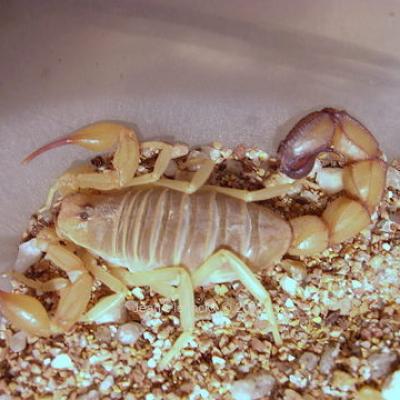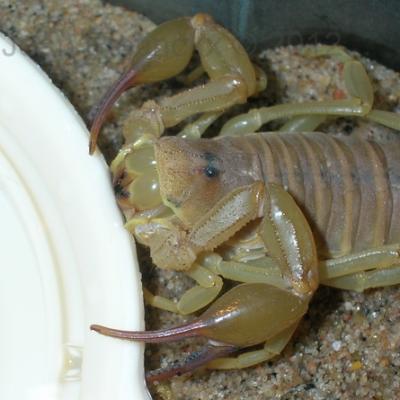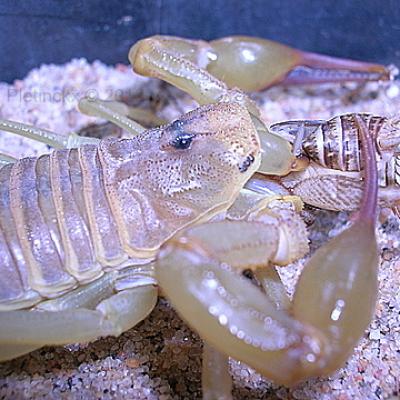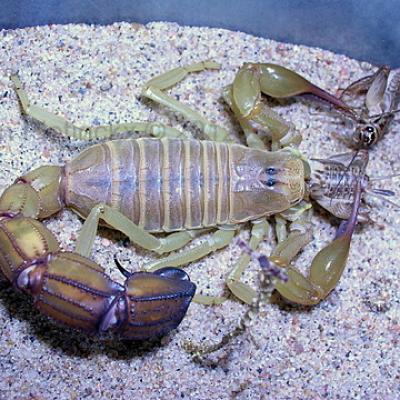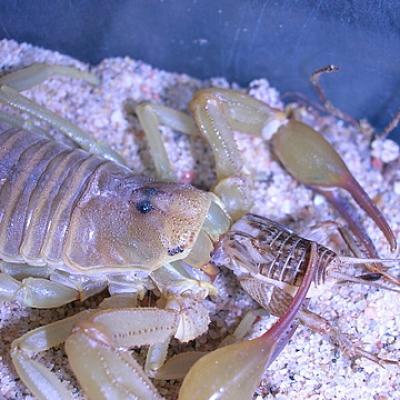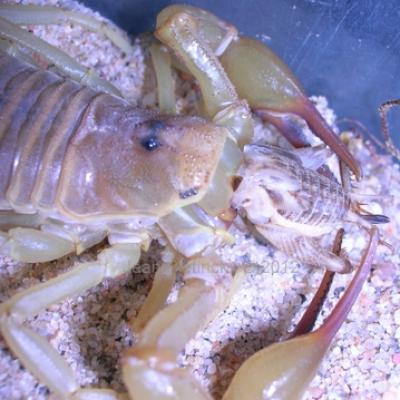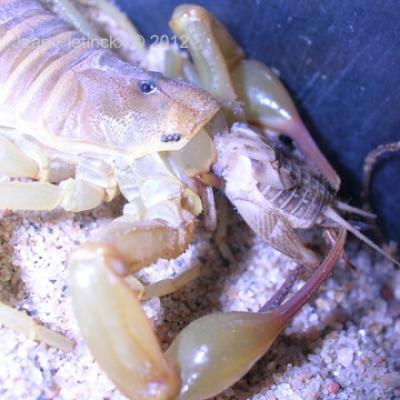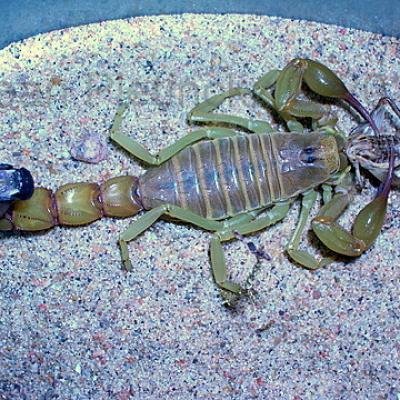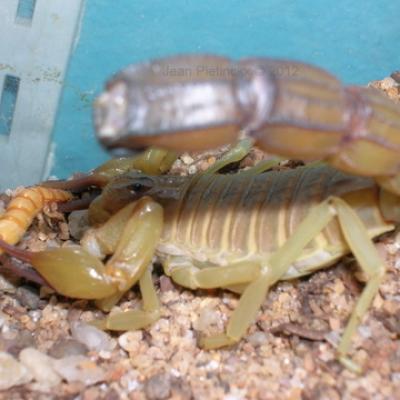Références.
-
Jahan S, Mohammed Al Saigul A, Abdul Rahim Hamed S. Scorpion stings in Qassim, Saudi Arabia, a 5 year surveillance report. Toxicon. Aug 2007;50 (2):302-5.
-
Langley RL, Morrow WE. Deaths resulting from animal attacks in the United States. Wilderness Environ Med. Feb 1997;8 (1):8-16.
-
Boyer L, Heubner K, McNally J, Buchanan P. Death from Centruroides scorpion sting allergy [abstract]. J Toxicol Clin Toxicol. 2001;39:561-562.
-
Freire-Maia L, Pinto GI, Franco I. Mechanism of the cardiovascular effects produced by purified scorpion toxin in the rat. J Pharmacol Exp Ther. Jan 1974;188 (1):207-13.
-
Bawaskar HS. Diagnostic cardiac premonitory signs and symptoms of red scorpion sting. Lancet. Mar 6 1982;1(8271):552-4.
-
[Best Evidence] Boyer LV, Theodorou AA, Berg RA, et al. Antivenom for critically ill children with neurotoxicity from scorpion stings. N Engl J Med. May 14 2009;360(20):2090-8.
-
Abroug F, Ayari M, Nouira S, et al. Assessment of left ventricular function in severe scorpion envenomation: combined hemodynamic and echo-Doppler study. Intensive Care Med. Aug 1995;21 (8):629-35.
-
Amaral CF, Dias MB, Campolina D, Proietti FA, de Rezende NA. Children with adrenergic manifestations of envenomation after Tityus serrulatus scorpion sting are protected from early anaphylactic antivenom reactions. Toxicon. Feb 1994;32 (2):211-5.
-
Amaral CF, Lopes JA, Magalhaes RA, de Rezende NA. Electrocardiographic, enzymatic and echocardiographic evidence of myocardial damage after Tityus serrulatus scorpion poisoning. Am J Cardiol. Mar 15 1991;67 (7):655-7.
-
Amaral CF, Rezende NA. Treatment of scorpion envenoming should include both a potent specific antivenom and support of vital functions. Toxicon. Aug 2000;38 (8):1005-7.
-
Amitai Y, Mines Y, Aker M, Goitein K. Scorpion sting in children. A review of 51 cases. Clin Pediatr (Phila). Mar 1985;24 (3):136-40.
-
Bahloul M, Ben Hamida C, Chtourou K, et al. Evidence of myocardial ischaemia in severe scorpion envenomation. Myocardial perfusion scintigraphy study. Intensive Care Med. Mar 2004;30 (3):461-7.
-
Bawaskar HS, Bawaskar PH. Clinical profile of severe scorpion envenomation in children at rural setting. Indian Pediatr. Nov 2003;40 (11):1072-5.
-
Bawaskar HS, Bawaskar PH. Severe envenoming by the Indian red scorpion Mesobuthus tamulus: the use of prazosin therapy. QJM. Sep 1996;89 (9):701-4.
-
Bergman NJ. Scorpion sting in Zimbabwe. S Afr Med J. Feb 1997;87 (2):163-7.
-
Bharani AK, Sepaha GC. Myelopathy after scorpion sting. Arch Neurol. Nov 1984;41(11):1130.
-
Biswal N, Mathai B, Bhatia BD. Scorpion sting envenomation: complications and management. Indian Pediatr. Aug 1993;30 (8):1055-9.
-
Bond GR. Antivenin administration for Centruroides scorpion sting: risks and benefits. Ann Emerg Med. Jul 1992;21(7):788-91.
-
Brand A, Keren A, Kerem E, Reifen RM, Branski D. Myocardial damage after a scorpion sting: long-term echocardiographic follow-up. Pediatr Cardiol. 1988;9 (1):59-61.
-
Carbonaro PA, Janniger CK, Schwartz RA. Scorpion sting reactions. Cutis. Mar 1996;57 (3):139-41.
-
Cupo P, Jurca M, Azeedo-Marques MM, Oliveira JS, Hering SE. Severe scorpion envenomation in Brazil. Clinical, laboratory and anatomopathological aspects. Rev Inst Med Trop Sao Paulo. Jan-Feb 1994;36 (1):67-76.
-
Curry SC, Vance MV, Ryan PJ, Kunkel DB, Northey WT. Envenomation by the scorpion Centruroides sculpturatus. J Toxicol Clin Toxicol. 1983-1984;21 (4-5):417-49.
-
Das S, Nalini P, Ananthakrishnan S, Sethuraman KR, Balachander J, Srinivasan S. Cardiac involvement and scorpion envenomation in children. J Trop Pediatr. Dec 1995;41 (6):338-40.
-
De Rezende NA, Dias MB, Campolina D, Chavez-Olortegui C, Diniz CR, Amaral CF. Efficacy of antivenom therapy for neutralizing circulating venom antigens in patients stung by Tityus serrulatus scorpions. Am J Trop Med Hyg. Mar 1995;52 (3):277-80.
-
Devi CS, Reddy CN, Devi SL, et al. Defibrination syndrome due to scorpion venom poisoning. Br Med J. Feb 7 1970;1(5692):345-7.
-
el-Amin EO. Issues in management of scorpion sting in children. Toxicon. Jan 1992;30 (1):111-5.
-
Freire-Maia L, Campos JA, Amaral CF. Approaches to the treatment of scorpion envenoming. Toxicon. Sep 1994;32(9):1009-14.
-
Gateau T, Bloom M, Clark R. Response to specific Centruroides sculpturatus antivenom in 151 cases of scorpion stings. J Toxicol Clin Toxicol. 1994;32 (2):165-71.
-
Ghalim N, El-Hafny B, Sebti F, et al. Scorpion envenomation and serotherapy in Morocco. Am J Trop Med Hyg. Feb 2000;62 (2):277-83.
-
Gibly R, Williams M, Walter FG, McNally J, Conroy C, Berg RA. Continuous intravenous midazolam infusion for Centruroides exilicauda scorpion envenomation. Ann Emerg Med. Nov 1999;34 (5):620-5.
-
Goyffon M, Vachon M, Broglio N. Epidemiological and clinical characteristics of the scorpion envenomation in Tunisia. Toxicon. 1982;20 (1):337-44.
-
Gueron M, Ilia R, Sofer S. The cardiovascular system after scorpion envenomation. A review. J Toxicol Clin Toxicol. 1992;30 (2):245-58.
-
Gueron M, Margulis G, Ilia R, Sofer S. The management of scorpion envenomation 1993. Toxicon. Sep 1993;31 (9):1071-83.
-
Gueron M, Weizmann S. Catecholamine excretion in scorpion sting. Isr J Med Sci. Jul-Aug 1969;5 (4):855-7.
-
Ismail M. The scorpion envenoming syndrome. Toxicon. Jul 1995;33 (7):825-58.
-
Karnad DR. Haemodynamic patterns in patients with scorpion envenomation. Heart. May 1998;79 (5):485-9.
-
Kric-Dautovic S, Begovic B. Acute renal insuffiency & toxic hepatitis folowing scorpion sting. Med arh. Feb 2007;61:123-4.
-
Krifi MN, Kharrat H, Zghal K, et al. Development of an ELISA for the detection of scorpion venoms in sera of humans envenomed by Androctonus australis garzonii (Aag) and Buthus occitanus tunetanus (Bot): correlation with clinical severity of envenoming in Tunisia. Toxicon. Jun 1998;36 (6):887-900.
-
Magalhaes MM, Pereira ME, Amaral CF, et al. Serum levels of cytokines in patients envenomed by Tityus serrulatus scorpion sting. Toxicon. Aug 1999;37 (8):1155-64.
-
Malhotra KK, Mirdehghan CM, Tandon HD. Acute renal failure following scorpion sting. Am J Trop Med Hyg. May 1978;27 (3):623-6.
-
Muller GJ. Scorpionism in South Africa. A report of 42 serious scorpion envenomations. S Afr Med J. Jun 1993;83(6):405-11.
-
Murthy KR, Hase NK. Scorpion envenoming and the role of insulin. Toxicon. Sep 1994;32 (9):1041-4.
-
Naqvi R, Naqvi A, Akhtar F, Rizvi A. Acute renal failure developing after a scorpion sting. Br J Urol. Aug 1998;82(2):295.
-
Nouira S, Boukef R, Nciri N, et al. A clinical score predicting the need for hospitalization in scorpion envenomation. Am J Emerg Med. May 2007;25 (4):414-9.
-
Otero R, Navio E, Cespedes FA, et al. Scorpion envenoming in two regions of Colombia: clinical, epidemiological and therapeutic aspects. Trans R Soc Trop Med Hyg. Dec 2004;98 (12):742-50.
-
Radmanesh M. Androctonus crassicauda sting and its clinical study in Iran. J Trop Med Hyg. Oct 1990;93 (5):323-6.
-
Radmanesh M. Cutaneous manifestations of the Hemiscorpius lepturus sting: a clinical study. Int J Dermatol. Jul 1998;37 (7):500-7.
-
Rajarajeswari G, Sivaprakasam S, Viswanathan J. Morbidity and mortality pattern in scorpion stings. (A review of 68 cases). J Indian Med Assoc. Oct 1979;73(7-8):123-6.
-
Reddy CR, Suvarnakumari G, Devi CS, Reddy CN. Pathology of scorpion venom poisoning. J Trop Med Hyg. May 1972;75(5):98-100.
-
Sofer S. Scorpion envenomation. Intensive Care Med. Aug 1995;21 (8):626-8.
-
Sundararaman T, Olithselvan M, Sethuraman KR, Narayan KA. Scorpion envenomation as a risk factor for development of dilated cardiomyopathy. J Assoc Physicians India. Nov 1999;47 (11):1047-50.
-
Tu A, ed. Handbook of Natural Toxins: Invertebrate Venoms. Vol 2. New York, NY: Marcel Dekker; 1984:513-678.
-
Velasco-Castrejon O, Lara-Aguilera R, Alatorre H. [Clinical and epidemiological aspects of scorpion sting in a hyperendemic area]. Rev Invest Salud Publica. Apr-Jun 1976;36 (2):93-103.

